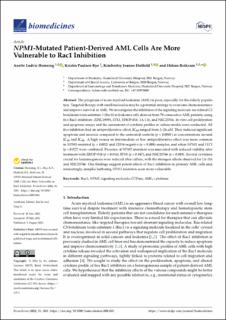| dc.contributor.author | Hemsing, Anette Lodvir | |
| dc.contributor.author | Rye, Kristin Paulsen | |
| dc.contributor.author | Hatfield, Kimberley Joanne | |
| dc.contributor.author | Reikvam, Håkon | |
| dc.date.accessioned | 2022-09-22T12:50:39Z | |
| dc.date.available | 2022-09-22T12:50:39Z | |
| dc.date.created | 2022-09-16T12:52:19Z | |
| dc.date.issued | 2022 | |
| dc.identifier.issn | 2227-9059 | |
| dc.identifier.uri | https://hdl.handle.net/11250/3020703 | |
| dc.description.abstract | The prognosis of acute myeloid leukemia (AML) is poor, especially for the elderly population. Targeted therapy with small molecules may be a potential strategy to overcome chemoresistance and improve survival in AML. We investigated the inhibition of the signaling molecule ras-related C3 botulinum toxin substrate 1 (Rac1) in leukemia cells derived from 79 consecutive AML patients, using five Rac1 inhibitors: ZINC69391, ITX3, EHOP-016, 1A-116, and NSC23766. In vitro cell proliferation and apoptosis assays and the assessment of cytokine profiles in culture media were conducted. All five inhibitors had an antiproliferative effect; IC50 ranged from 3–24 µM. They induced significant apoptosis and necrosis compared to the untreated controls (p < 0.0001) at concentrations around IC40 and IC80. A high versus an intermediate or low antiproliferative effect was more common in NPM1-mutated (p = 0.002) and CD34-negative (p = 0.008) samples, and when NPM1 and FLT3 (p = 0.027) were combined. Presence of NPM1 mutation was associated with reduced viability after treatment with EHOP-016 (p = 0.014), ITX3 (p = 0.047), and NSC23766 (p = 0.003). Several cytokines crucial for leukemogenesis were reduced after culture, with the strongest effects observed for 1A-116 and NSC23766. Our findings suggest potent effects of Rac1 inhibition in primary AML cells and, interestingly, samples harboring NPM1 mutation seem more vulnerable. | en_US |
| dc.language.iso | eng | en_US |
| dc.publisher | MDPI | en_US |
| dc.rights | Navngivelse 4.0 Internasjonal | * |
| dc.rights.uri | http://creativecommons.org/licenses/by/4.0/deed.no | * |
| dc.title | NPM1-Mutated Patient-Derived AML Cells Are More Vulnerable to Rac1 Inhibition | en_US |
| dc.type | Journal article | en_US |
| dc.type | Peer reviewed | en_US |
| dc.description.version | publishedVersion | en_US |
| dc.rights.holder | Copyright 2022 by the authors | en_US |
| dc.source.articlenumber | 1881 | en_US |
| cristin.ispublished | true | |
| cristin.fulltext | original | |
| cristin.qualitycode | 1 | |
| dc.identifier.doi | 10.3390/biomedicines10081881 | |
| dc.identifier.cristin | 2052472 | |
| dc.source.journal | Biomedicines | en_US |
| dc.identifier.citation | Biomedicines. 2022, 10 (8), 1881. | en_US |
| dc.source.volume | 10 | en_US |
| dc.source.issue | 8 | en_US |

